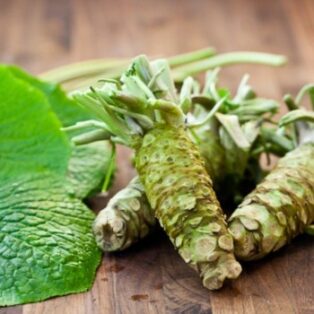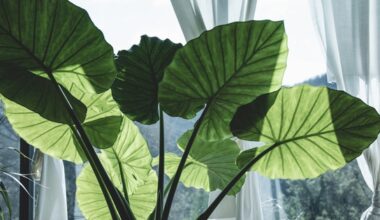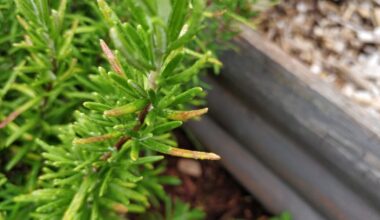Japanese condiment plant par excellence, the wasabi or Japanese mustard is a perennial plant that is also cultivated here! Attention, its culture is difficult.
Contents
What can you do with wasabi?
We use the root (about 4 inches long by 1 inch in diameter) which is finely grated as a condiment for cooking, a bit like horseradish. In fact, wasabi, horseradish and mustard are all Brassicaceae.
Because of its extremely strong, slightly pungent taste that rises to the nose, it is common to speak of Japanese mustard or Japanese horseradish instead of saying “wasabi”. However, their flavors are different.
Wasabi is used to make the spicy sauce of the same name, but it also spices up meat or fish dishes, soups, rice, and flavors pastries and other by-products by fashion effect! Run away from wasabi in a tube!
Its antibacterial properties are recognized, as well as the fight against respiratory diseases, but it is also believed to have anti-cancer properties…
- Family : Brassicaceae
- Type : perennial
- Origin : Japan
- Color : white flowers
- Sowing : yes
- Cutting : no
- Planting : Spring
- Flowering : Spring
- Height: up to 30 inches
How to grow wasabi
Wasabi is difficult to grow. It does not tolerate frost, direct sunlight or temperatures above 68°C, and attracts slugs. But it is possible to cultivate it by following some advices.
It is above all a plant of wet environment. The ground must never dry, even during its vegetative rest. The wasabi can be cultivated in edge of brook, or wet zone, and even covered with a small layer of water. It requires a soil with an acidic tendency, which can be humic or heavy, of clay-silt type and a shady or semi-shady exposure with a little sun in the morning. Its growth is slow, the plant becomes mature between 18 months and 3 years.
In pot, the wasabi is installed in a deep container and a saucer always containing a few centimeters of fresh water. It can be overwintered in a cold frame or greenhouse or in the cellar.
It is hardy down to -10°F.
Maintenance and cultivation of wasabi
Extremely difficult to cultivate, wasabi requires constant monitoring. Wasabi is sensitive to light, temperature, and requires perfect irrigation, so drip watering can be beneficial and will keep the wasabi leaves from wilting.
Requires a lot of water and even tolerates running water.
It grows only in a cool, moist environment. A culture in greenhouse is particularly suitable for this plant, in particular to be able to easily meet its requirements.
Only advantage: the wasabi is not pruning. Make sure, however, that you remove the wilted leaves.
How to plant wasabi
Wasabi is grown in the shade, away from direct sunlight, at a temperature between 53 and 59°F, in deep, well-drained soil.
Being a water plant, pot cultivation requires a layer of donated clay beads to facilitate drainage.

Grow wasabi in pot
Wasabi can be grown in pots, but always make sure to water it carefully. The chosen potting soil must be of good quality. To aerate the substrate as much as possible, it is possible to alternate a layer of clay balls and a layer of potting soil. And to facilitate water drainage, make holes also on the vertical wall of the pot.
How to water wasabi
Since wasabi constantly needs a moist soil, it is best to install a drip irrigation system. Regularly monitor the substrate so that it never dries out!
Cold resistance of wasabi
Wasabi is not frost resistant but can occasionally withstand temperatures close to zero. The plants must be overwintered in greenhouses, verandas or in the house (beware of overheated interiors which are not suitable for it). This is why hobby gardeners grow it mainly in pots.
Wasabi Foliage
The foliage of wasabi is evergreen. The leaves are large heart-shaped (about 20cm), thick and the young leaves have a nice bronze green tint. They are edible in salads, but their taste is not as strong as that of the root.
Multiply the wasabi
Any small rhizome branches present on mature plants can be replanted.
By sowing. The harvested seeds are sown as soon as possible. The sowing must be in water. It needs to undergo a winter before the seeds germinate.
How to harvest wasabi
Harvest the wasabi root when it is around 1 inch in diameter. The leaves are also edible, although it is the roots that are considered the best part of the plant.
Wasabi diseases and pests
Wasabi is affected by few diseases. However, slugs, snails and caterpillars enjoy wasabi plants.
In prevention, in particular for snails or slugs, install beer traps or opt for ash barriers to protect the plants from their attacks.
How to use wasabi?
Roots can be harvested after 18 months, rarely faster. The plant is uprooted, the stems and leaves are sometimes used as vegetables in Japan, but it is the “carrot”, once removed from its roots that gives the condiment. Its taste is finely spicy and ends in a vegetal note, which is not without reminding the artichoke or asparagus.
It doesn’t take much to flavor meat, fish, soup, Asian noodles… the wasabi rhizome, well wrapped and chilled, can be kept for a few weeks, like fresh ginger.
Wasabi is delicious when fresh. Crushed or grated, it begins to lose its taste after 20 minutes. It should therefore always be added at the last moment to your dishes.
Summary
The best conditions for growing wasabi matsuma is a wetland in the middle of trees or shrubs, near a stream or river, lake or pond. Stagnant water and compact clay soils should be avoided. The mountainous zones of medium altitude are well laid out because the optimal temperature of culture of this perennial plant is between 44 and 71°F.
It is thus necessary to avoid the areas with the very cold winters or the very hot and dry summers. It is never necessary to plant wasabi in full sun. In addition to the shade, it is necessary a fresh and wet environment. The culture under shelter is possibly provided that the temperature can be regulated, especially in summer, and that there is a shady area.









